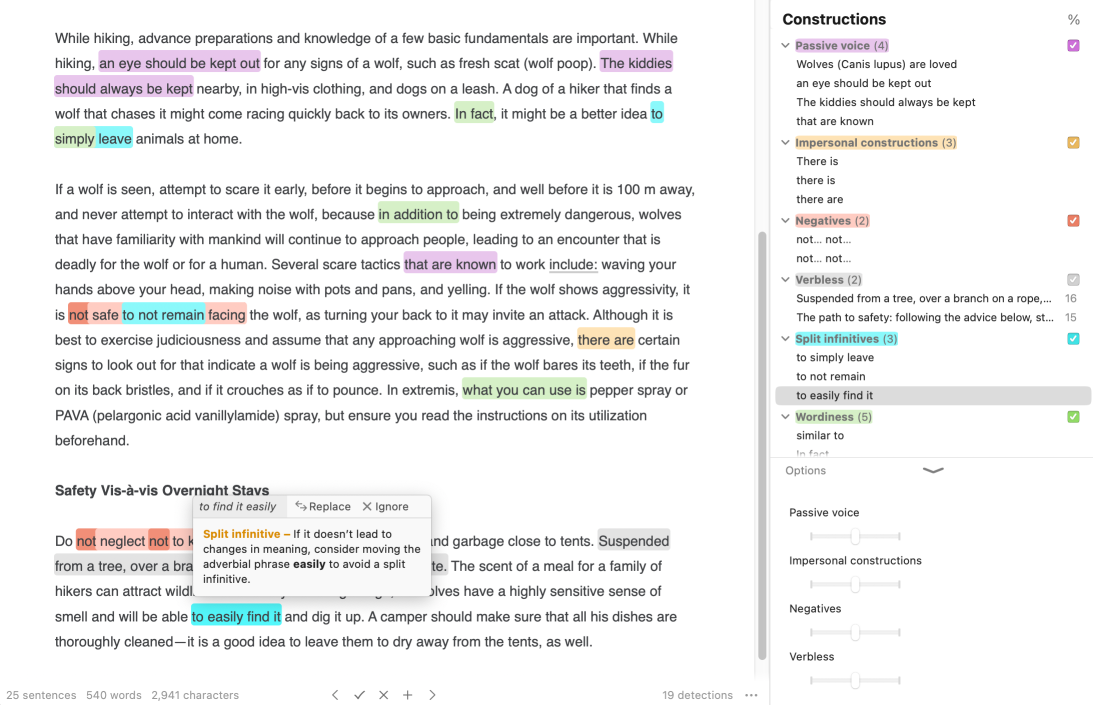Constructions
An important source of a text’s verve is its syntax; ideally, we would like it to be varied, fluid and elegant. The corrector flags certain constructions: the passive voice, impersonal or negative constructions, verbless sentences and wordiness. These are not incorrect, neither should they be systematically avoided, but their usage merits close attention.
-
 A123B
A123B
Passive voice
Passive constructions (in which the verb is conjugated with be and the subject undergoes the action rather than being the active agent, e.g. the film was lauded by the critics) are useful when you want to focus on the object rather than the subject. Otherwise, an equivalent sentence in the active voice usually has more impact (e.g. the critics lauded the film). A text with too many passives can seem impersonal or detached.
- Clicking the options bar will show you a slider that allows you to choose whether to perform an exhaustive check or to speed things up by focusing only on the most blatant cases of the construction in question. See the tooltips associated with each of the slider’s positions to help you decide which one to select.
Impersonal constructions
Antidote can quickly locate impersonal constructions in your text and help you avoid overusing them. Although they are at times useful, impersonal constructions have the disadvantage of moving the real subject to the end of the sentence. This is appropriate if you want to put emphasis on the theme of a sentence. In other cases, however, an impersonal construction (e.g. it is imperative that…) can make your text feel cumbersome.
- Clicking the options bar will show you a slider that allows you to choose whether to perform an exhaustive check or to speed things up by focusing only on the most blatant cases of the construction in question. See the tooltips associated with each of the slider’s positions to help you decide which one to select.
Negatives
Make sure that negative constructions effectively convey your intended meaning, particularly when a sentence contains more than one negation. It can be a challenge to understand multiple negations when they are embedded within each other or appear in succession (e.g. it isn’t impossible that she won’t arrive on time). As a general matter of style, it is usually preferable to reformulate negative constructions as positive ones, provided that the negation is not essential to your message.
- Clicking the options bar will show you a slider that allows you to choose whether to perform an exhaustive check or to speed things up by focusing only on the most blatant cases of the construction in question. See the tooltips associated with each of the slider’s positions to help you decide which one to select.
Verbless sentences
Because it expresses the action that links the subject and its object, the verb normally forms the nucleus of the sentence. Hence, a sentence without a verb or with a nonverbal nucleus immediately appears questionable. The corrector highlights sentences in your text that lack a main verb, letting you determine whether you should instead paraphrase using an explicit subject and verb.
- Antidote ignores titles when checking for verbless sentences.
- The number displayed to the right of each detection shows the number of words in each verbless sentence. Longer verbless sentences are more likely to be the result of an omitted word, so you may want to check them first.
- Clicking the options bar will show you a slider that allows you to choose whether to perform an exhaustive check or to speed things up by focusing only on the most blatant cases of the construction in question. See the tooltips associated with each of the slider’s positions to help you decide which option to select.
Split infinitives
A verb in the infinitive is said to be “split” when an adverb is placed between the particle to and the verb itself (e.g. to heartily agree). Split infinitives are widely accepted in both written and spoken English. Nonetheless, they are occasionally considered incorrect. If this concerns you, using this filter will allow you to locate and reformulate split infinitives if you consider it necessary.
Dangling prepositions
Prepositions that come after their objects can be said to be “dangling” (e.g. It’s nothing to worry about.). Although this practice is a common and standard feature of English, it is sometimes criticized as inelegant in certain contexts. This filter allows you to identify and reformulate dangling prepositions as needed.
Wordiness
This filter locates passages in which many words are used to express a relatively simple idea. These wordy constructions can usually be reformulated, making your text lighter and easier to read. For example, you may want to replace what you can do is with you can, or in addition to with and.
- The tooltip proposes several actions depending on the cases it detects. See the Characteristics of the detections in the Style view section to learn more about each function.
- The examples presented in the guide article that describe the detected issue may provide inspiration. Click the orange tooltip title that precedes the explanation to consult the corresponding article.